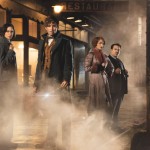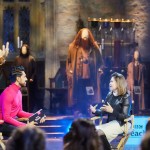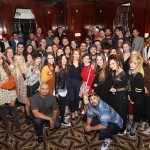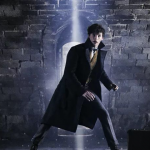‘Fantastic Beasts’ Insiders Discuss Behind-the-Scenes Details

Feb 15, 2017
Colleen Atwood, Fantastic Beasts Movie, Films, Interviews, Movies, News, Props-Sets
So much work went into Fantastic Beasts and Where to Find Them to make it the incredible cinematic experience it is, it’s no surprise there are so many behind-the-scenes details still coming out, as industry veterans proudly discuss their craft and contributions to the film. Most recently, costume designer Colleen Atwood and Framestore creative director Christian Manz had opportunities to share their inside perspectives on the making of Fantastic Beasts.
Christian Manz spoke to fans at the VFX Festival in London, sharing some exciting new information about the beasts that made it into the film–and a few that didn’t! Manz divulged that Framestore actually designed about 200 creatures, drawing inspiration from JK Rowling’s textbook, screenplay and, in some cases, their own imaginations.
The designers understood their responsibility to the story and Rowling’s wizarding world, however. They made no arbitrary inclusions or deletions, nor did they select creatures for effect alone. They were very purposeful, knowing that each beast to make it into the film needed to have a unique contribution, something to make it special and interesting.
Manz told the crowd:
“Story is important in moviemaking, and we didn’t want a creature there for its own sake…And in this scene, you’d see creatures once. So we wanted everything to have a gag, something that would make you remember it.”
One idea that didn’t make it through the initial stages of the creative process included tree-forming lizards, in which a colony of lizards would structure themselves into the shape of a tree. They also scrapped the idea of a hideous fish cleverly disguised by its beautiful company.
Manz explained that not all cuts were made by the production team; some ideas didn’t make it past the series creator herself. It seems JK Rowling had a very active role in the decision-making process, specifically nixing one magical idea. He revealed:
“The ice turtle – another thing of trying to explain away natural things as, maybe that is hidden under [an iceberg]…But as it says here – I think that was Jo Rowling thought film 3 maybe, but it’s a bit too much for Newt. Too huge a scale for the sort of film we’re doing.”
We’ll be interested to see which of Rowling’s beasts make it into future films–and why they’re chosen. The creative teams involved in the Harry Potter and Fantastic Beasts series are experts in their fields, and it’s exciting to get this insight into how the vision comes together.
The film isn’t composed of special effects alone, however. The magic is also created through the sets and props, the characters and how they interact with one another, and the costumes which transport them from the muggle world to the wizarding realm. Costume designer Colleen Atwood spoke to Goldderby recently about her involvement in the film.
Goldderby asked her to speak on how she so deftly blended period dress with the fantasy elements of the film. Atwood explained that she wanted the costumes to clearly evoke the 1920s period while still feeling accessible to the viewers and, of course, adding a wizarding twist.
She revealed that, for her, it all began with reading the story and getting to know the characters, thereby developing her own interpretation which she could then incorporate with the vision of the director and the actors themselves. Her next step was to draw inspiration from period research and character photographs, as well as the concept work in the art department–anything that informed the desired mood of the story. Then she considered how to reflect the diverse melting pot of the grand city of New York, intentionally selecting costumes that could be identified with the different cultural or social groups represented there.
Atwood added that she brought magic into the costumes by referencing the magical beasts designed by the many special effects contributors. It made sense to use colors that would compliment the creatures, especially for Eddie Redmayne’s Magizoologist, Newt Scamander, who needed to seem other-worldly but also be able to pass through the muggle world without drawing undue attention.
She concluded by discussing how it was important to make each costume work practically, considering what the actor would be called to do in it–from tailoring Redmayne’s coat for constant sitting and standing to the ability to hide a harness. It’s amazing how much detailed planning goes into every aspect of production so that we end up with a final product that’s unquestionably fantastic in every way!
For a more in-depth breakdown of Framestore’s contributions to the film, check out Leaky’s previous coverage of their special effects work here and read the Radio Times article on Christian Manz’s VFX Festival appearance here.
Also read Goldderby’s article on Colleen Atwood’s extensive experience and record of Oscar nominations and wins here. View their full webcam chat below.





